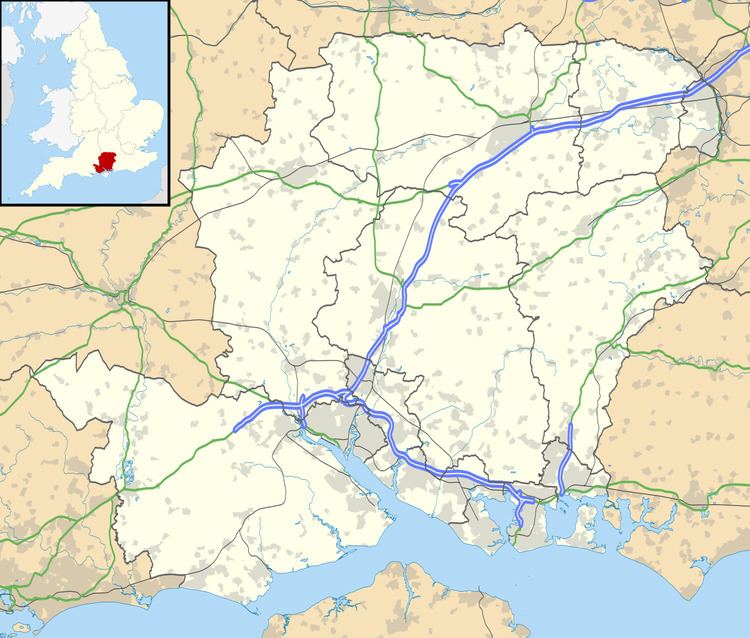Population 650 (2011 Census) Sovereign state United Kingdom | OS grid reference SU292455 Post town ANDOVER Local time Friday 10:58 AM Dialling code 01264 | |
 | ||
Weather 12°C, Wind S at 23 km/h, 80% Humidity | ||
Thruxton is just off the A303 road five miles (8 km) west of Andover. It is a village with a Manor House, thatched cottages and village green. Pillhill Brook runs from Thruxton Down through the grounds of the Manor House and along the village street to Mullen's Pond, a natural habitat for many species of migratory birds and wild plants.
Contents
Map of Thruxton, Andover, UK
History
Thruxton was almost certainly one of four ‘Annes’ named in the Domesday Book under the Andover Hundred. In the twelfth century the name was Turkilleston (Turkil being a Saxon name and ‘tun’ being the Saxon word for farmstead and later hamlet, or village - so Turkils or Thurcols Homestead ) which, over the centuries, changed via Turcleston, Thorcleston (13th century), Throkeleston, Thurkcleston (14th century), Throkeston (15th century), Thruckleston (16th century), Throxton (18th century) to the present form.
A Roman building considered to be a temple or a basilican villa was unearthed near the village in 1823, which contained a mosaic depicting Bacchus seated on a tiger. The tessellated pavement was acquired for the British Museum in 1899.
The manor was held in 1086 by Gozelin de Cormeilles; in 1304, his descendant, John de Cormeilles, was granted the right to hold a market every Monday and a fair on the eve of the feast of St Peter and St Paul (the saints the village church is dedicated to).
Parts of the parish church of St Peter and St Paul's date from the thirteenth centuryand contain the tombs of three knights.
Two coffin slabs for two of the knights stand upright at the entrance in the bell tower. Made of purbeck marble, they are heavily weathered, although the great helm and shield of one is still discernible. His spear lies beside him on his right side.
Just when the de Cormeilles family parted with the manor of Thruxton and how the Lisles acquired it is unknown. Sir John Lisle and his wife are buried in the church, with Sir John commemorated with an outstanding example of an early 15th-century monumental brass.
Further generations of Lisle family were buried in the church, although by the time of Sir John Lisle in the early 1520s, space was becoming restricted. He decided to build a chapel to provide further room for future burials, including his own.
Sir John died in 1524, followed shortly by his wife, Mary. Their tomb is considered a classic of the early English Renaissance style and can be seen to the left of the altar. The effigies are made from Purbeck marble. Sir John lies with his bare head on his shield, wearing full plate armour and chain collar of linked "S"s. The work was possibly by Thomas Bertie, a master mason whose work is evident in Winchester Cathedral.
The bulk of the Lisle chapel is, sadly, gone. Most of it was used to provide building material when the church tower collapsed in 1796 and had to be rebuilt.
The Lisle line of direct male heirs died out soon after Sir John and Mary, with the manorial rights passing to Agnes, married to John Philpot. Behind the choir pews on the left of the altar is a weathered wooden effigy from the early 17th century, believed to be of Elizabeth Philpot.
The toll house for Andover to Amesbury turnpike road at Mullen's Pond was demolished in 1965.
Race track
Thruxton Circuit is a major draw for visitors to the area and can claim to be Britain's fastest motor racing circuit. Currently the track plays host to a variety of high-profile car and motorbike championships, including the British Superbike and British Touring Car Championships, as well as truck racing. The circuit is located on the site of the former aircraft base.
Airfield
RAF Thruxton was first used on 22 June 1942 by Blenheims of no.2 spc. During 1942/43 the airfield was used by many different RAF squadrons. In January 1942, 12 Whitley bombers landed in preparation for the now famous Bruneval raid which took place on 27/28 February 1942. The Americans arrived in 1944 with their P-47 Thunderbolts under the command of Col. Dyke F Meyer.
Civilian flight training started at Thruxton Aerodrome in 1947 when the airfield was taken over by The Wiltshire School of Flying until 1967. Western Air then took on the mantle of training people to fly and even today their instructors are teaching some of the local military the delights of flying light aircraft. For some years it was also the home of Thruxton Gliding Club.
The airfield is the base of the Hampshire & Isle of Wight Air Ambulance, since its founding in 2007.
Public houses
There are two village pubs; the White Horse, a fifteenth-century thatched pub at Mullens Pond south of the A303, and the George Inn, a coaching inn dating from the seventeenth centurynear the centre of the village.
